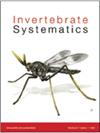Molecular phylogeny, systematics and biogeography of the subfamily Nemognathinae (Coleoptera, Meloidae)
IF 1.9
2区 生物学
Q3 EVOLUTIONARY BIOLOGY
引用次数: 2
Abstract
Abstract. Nemognathinae is the most widespread subfamily of Meloidae, with ~600 species, and includes the only blister beetles distributed in Australia and on islands of the western Pacific. Four tribes are recognised based on morphology: Stenoderini, Palaestrini, Horiini and Nemognathini. Using two mitochondrial (16S, COI) and three nuclear markers (CAD, 28S, ITS2), and both maximum likelihood and Bayesian approaches, this study describes the evolutionary history of Nemognathinae based on molecular data for the first time. We provided a fossil-calibrated phylogeny that unravels the phylogenetic relationships among the tribes and among most of the genera, and a reconstruction of the biogeographic history using a parametric approach. Our results recognised the four tribes that were described previously based on morphology and revealed the presence of another well-differentiated clade corresponding to the genus Zoltanzonitis. Phylogenetic relationships among the tribes are well supported, with Stenoderini as the most ancient lineage, followed by Zoltanzonitini, Palaestrini, Horiini and Nemognathini. A few long-standing genera within Nemognathini (Nemognatha, Zonitis, Stenoria) and the nominate subgenus Stenodera (Stenodera) were recovered as polyphyletic. In addition, biogeographic analyses revealed the origin of the subfamily in the Old World during the Eocene, and the associated diversification into the five tribes astride the Eocene and Oligocene between 46 and 30 Ma. Based on these results we propose the new tribe Zoltanzonitini, and the elevation of the subgenus Pronemognatha to genus level, new status. In addition, Zonitoschema breveapicalis new comb., Z. curticeps new comb. and Z. pulchella new status are proposed. ZooBank: urn:lsid:zoobank.org:pub:72EECC6D-36A6-4DD7-B4DB-D0692034E775.线虫亚科的分子系统发育、系统分类学和生物地理学(鞘翅目,蝇科)
摘要线虫亚科(Nemognathinae)是线虫科分布最广的亚科,约有600种,包括分布在澳大利亚和西太平洋岛屿上的唯一水疱甲虫。根据形态识别出四个部落:Stenoderini、Palaestrini、Horiini和Nemognathini。利用两个线粒体(16S,COI)和三个核标记(CAD,28S,ITS2),以及最大似然和贝叶斯方法,本研究首次基于分子数据描述了Nemognathinae的进化史。我们提供了一个化石校准的系统发育学,揭示了部落和大多数属之间的系统发育关系,并使用参数方法重建了生物地理学历史。我们的结果根据形态学识别了之前描述的四个部落,并揭示了另一个分化良好的分支的存在,对应于Zoltanzonitis属。部落之间的系统发育关系得到了很好的支持,Stenoderini是最古老的谱系,其次是Zoltanzonitini、Palaestrini、Horiini和Nemognathini。Nemognathini中的几个长期存在的属(Nemognath、Zonitis、Stenoria)和被提名的Stenorera亚属(Stenorera)被恢复为多系。此外,生物地理学分析揭示了该亚科起源于始新世的旧大陆,并在46至30 Ma之间分化为横跨始新世和渐新世的五个部落。基于这些结果,我们提出了新的部落Zoltanzonitini,并将叉颚亚属提升到属级,新的地位。此外,薄叶拟带虫新梳。,Z向新梳子行屈膝礼。并提出了Z.pulchella的新地位。ZooBank:urn:lsid:ZooBank.org/pub:72ECC6D-36A6-4DD7-B4DB-D0692034E775。
本文章由计算机程序翻译,如有差异,请以英文原文为准。
求助全文
约1分钟内获得全文
求助全文
来源期刊

Invertebrate Systematics
生物-动物学
CiteScore
4.30
自引率
9.10%
发文量
35
审稿时长
>12 weeks
期刊介绍:
Invertebrate Systematics (formerly known as Invertebrate Taxonomy) is an international journal publishing original and significant contributions on the systematics, phylogeny and biogeography of all invertebrate taxa. Articles in the journal provide comprehensive treatments of clearly defined taxonomic groups, often emphasising their biodiversity patterns and/or biological aspects. The journal also includes contributions on the systematics of selected species that are of particular conservation, economic, medical or veterinary importance.
Invertebrate Systematics is a vital resource globally for scientists, students, conservation biologists, environmental consultants and government policy advisors who are interested in terrestrial, freshwater and marine systems.
Invertebrate Systematics is published with the endorsement of the Commonwealth Scientific and Industrial Research Organisation (CSIRO) and the Australian Academy of Science.
 求助内容:
求助内容: 应助结果提醒方式:
应助结果提醒方式:


